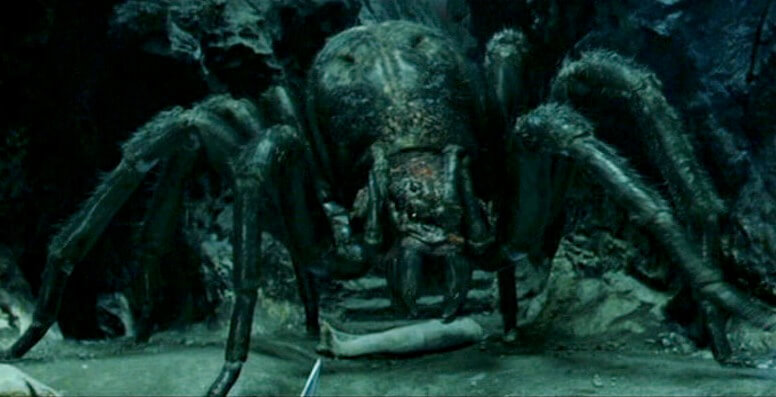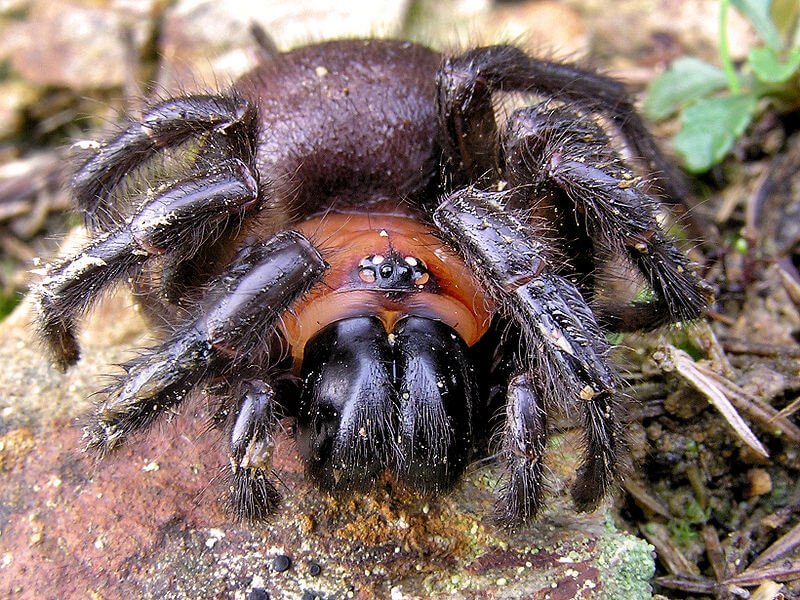What’s the most famous — or even the most infamous — spider in the world? The tarantula? The black widow? Actually, it’s possibly a hairy horror that few have heard of but that millions have seen — the tunnelweb spider (Porrhothele antipodiana).
And here’s a clue to this seeming paradox: “[S]he served none but herself, drinking the blood of Elves and Men, bloated and grown fat with endless brooding on her feasts, weaving webs of shadow; for all living things were her food, and her vomit darkness.”
That’s JRR Tolkien’s account of Shelob, the “Great Spider” that guarded the dark tunnels leading into the foul kingdom of Mordor in Lord of the Rings. This vivid written description, as legions of terrified movie-goers will attest, was then brought to horrifying ‘life’ by director Peter Jackson in the final installment of his Oscar-winning LOTR trilogy of films … and Jackson, in turn, used “the one spider he’d hated through his life” as inspiration for the terrifying monster that very nearly devoured the Ring-bearing hobbits, Frodo and Sam: the “reclusive but powerful” tunnelweb spider of Jackson’s homeland, New Zealand.
Indeed, Shelob and the tunnelweb share another feature in common — that very little is known of their origins. In Shelob’s case, this follows from the arcane nature of Tolkien’s imaginative scribblings; with the tunnelweb, though, this is due to the cryptic lifestyle of the arachnid itself, lurking as it does in its eponymous web tunnel under hard-to-access rocks and logs.

Yet, while the details of the tunnelweb’s behavior are still uncertain, its evolutionary relationship with other arachnids — real ones, that is, not creatures of fantasy-horror — are becoming increasingly clear, thanks in large part to modern genomics.
Based on similarities in anatomy and other traits, the tunnelweb was already known to be related to the notorious Sydney funnel-web spider of Australia (a contender for most venomous spider in the world) and, more distantly, the tarantula. (Indeed, a similar distant genetic relationship exists between two fearsome spider-hunting wasps – the American tarantula hawk and the New Zealand golden hunter – both of which use paralysed arachnids as living larders for their young).
However, recent genetic research is now re-writing the phylogenetic tree of these eight-legged critters, showing that some are much more closely related than previously thought. And nor is this simply of interest to ardent arachnologists or tidy-minded taxonomists; as some of the most poisonous invertebrates in the world, greater knowledge of their evolution — and more especially, that of their venom — may help in developing general purpose antivenoms and bio-insecticides, and perhaps even treatments for victims of stroke.
Back in New Zealand, however, genomic study of another endemic spider species is revealing far more threatening information — at least to the country’s sense of national pride.
It has long been feared that the native katipo, a venomous ‘widow spider’ related to the infamous North American black widow, was in serious decline due to pressure from two exotic introduced species. Yet it is not just the potential disappearance of a native animal causing the concern — it is the origin of the competition.
On the sporting field — and, in particular, with the national game, rugby union — New Zealand’s bitterest rivalries are with fellow former-British colonies, South Africa and Australia. (As an amusing aside, the New Zealand rugby team are called the All Blacks after the colour of their shirts; the national men’s soccer and basketball teams, meanwhile, are respectively the All Whites and the Tall Blacks.)
Yet while the Kiwis (as New Zealanders are also known) regularly pummel their southern hemisphere opponents on the rugby park, it’s a different story on the country’s beaches, where the katipo spider naturally resides. Here, the native species is being overrun by a South African interloper — the black cobweb spider or ‘false katipo’. Although this is ecologically concerning, in terms of national pride it appears that sheer weight of numbers rather than superior spider strength or skill is giving the South Africans an advantage, with the false katipo simply having a far wider range than the ‘real’ one. The situation with the Australian redback spider, the other recently arrived arachnid rival, however, carries much more of a sting – one that particularly pricks at Kiwi males’ macho self-esteem.
Modern genetic research suggests that the time since the katipo and the redback diverged is evolutionarily recent, with ancestral katipo thought to have ‘ballooned’ from Australia to New Zealand on threads of web. (Non-native redbacks, by contrast, were accidentally introduced only within the last few decades.) Given these spiders’ close genetic relationship, katipo and redbacks can still interbreed — though with one rather weighty qualification.
Male katipo are considerably larger than their Australian counterparts — a seeming ‘advantage’ that is anything but. Amorous male katipo are simply regarded as prey by hungry female redbacks, with the former invariably ending up as a meal rather than a mate. By contrast, male redbacks face no such sexual handicap, with female katipo readily mating with the smaller (and sneakier) Australian arachnids. (As an added bonus, female katipo do not indulge in sexual cannibalism like other widow spiders — including the female redback — so the Australian male survives to tell the tale.)
The katipo-redback hybrids that result, however, are more than just a threat to the native species (through genetic ‘swamping’) or to Kiwi males’ masculine ego. As highly venomous creatures, any expansion of the redback population could have serious health implications for New Zealanders, who (aside from the shy and non-aggressive katipo itself) face no other poisonous animals beyond bees and wasps.
This, though, indicates the limitations of genetic scrutiny of otherwise difficult to study invertebrates. DNA analysis can, of course, usefully illuminate evolutionary relationships, as well as massively assisting with invertebrate classification (a particular problem with juveniles, say, or with poorly preserved museum specimens). Furthermore, as illustrated by the katipo and redbacks, such research can also highlight interbreeding between related species. Genetic analysis cannot, however, tell us much about the lifestyle and behavior of these animals, for which the traditional ecologists’ observations and recordings are still vitally important.
Indeed, long before the arrival of Europeans in New Zealand, the katipo spider’s fearsome reputation had been recorded in the oral traditions of the indigenous Maori people (with the name katipo or ‘night stinger’ possibly stemming from bites received while collecting driftwood for evening fires). Unlike redbacks, however — and funnel webs and black widows and the like — records of fatalities due to katipo are few and far between, with the last death reported in the 1800s.
This, though, was probably of little comfort to a Canadian tourist whose encounter with a female katipo (the venomous sex) was reported in 2010 under headlines such as “Agony after spider bites trouser snake” and “Skinny dipper bitten on manhood by deadly New Zealand spider”. Still, while the unfortunate naked visitor had to spend two weeks recovering in hospital, his painful accident did at least prove that, unlike Australians, North American males are clearly large enough to make an impression.
Patrick Whittle has a PhD in philosophy and is a freelance writer with a particular interest in the social and political implications of modern biological science. Follow him on his website patrickmichaelwhittle.com or on Twitter @WhittlePM































